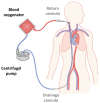Simulators and Simulations for Extracorporeal Membrane Oxygenation: An ECMO Scoping Review
- PMID: 36902552
- PMCID: PMC10003420
- DOI: 10.3390/jcm12051765
Simulators and Simulations for Extracorporeal Membrane Oxygenation: An ECMO Scoping Review
Abstract
High-volume extracorporeal membrane oxygenation (ECMO) centers generally have better outcomes than (new) low-volume ECMO centers, most likely achieved by a suitable exposure to ECMO cases. To achieve a higher level of training, simulation-based training (SBT) offers an additional option for education and extended clinical skills. SBT could also help to improve the interdisciplinary team interactions. However, the level of ECMO simulators and/or simulations (ECMO sims) techniques may vary in purpose. We present a structured and objective classification of ECMO sims based on the broad experience of users and the developer for the available ECMO sims as low-, mid-, or high-fidelity. This classification is based on overall ECMO sim fidelity, established by taking the median of the definition-based fidelity, component fidelity, and customization fidelity as determined by expert opinion. According to this new classification, only low- and mid-fidelity ECMO sims are currently available. This comparison method may be used in the future for the description of new developments in ECMO sims, making it possible for ECMO sim designers, users, and researchers to compare accordingly, and ultimately improve ECMO patient outcomes.
Keywords: classification; extracorporeal life support (ECLS); fidelity; model; simulation training.
Conflict of interest statement
The authors declare no conflict of interest. The funder had no role in the design of the study; in the collection, analyses, or interpretation of data; in the writing of the manuscript; or in the decision to publish the results.
Figures
References
-
- Nunez J.I., Gosling A.F., O’Gara B., Kennedy K.F., Rycus P., Abrams D., Brodie D., Shaefi S., Garan A.R., Grandin E.W. Bleeding and thrombotic events in adults supported with venovenous extracorporeal membrane oxygenation: An ELSO registry analysis. Intensive Care Med. 2022;48:213–224. doi: 10.1007/s00134-021-06593-x. - DOI - PMC - PubMed
Publication types
Grants and funding
LinkOut - more resources
Full Text Sources


